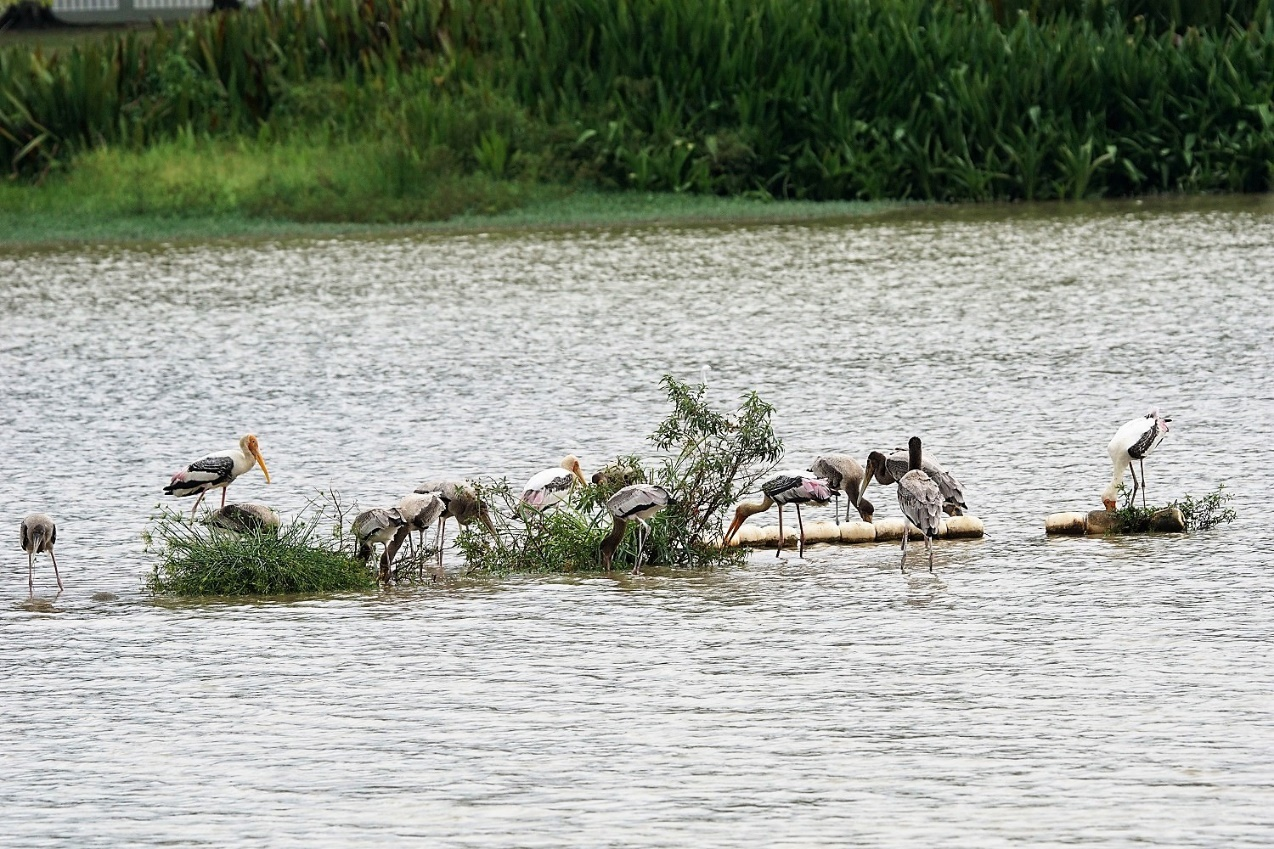IUCN/SSC Otter Specialist Group Bulletin

©IUCN/SCC Otter Specialist Group
Volume 36 Issue 2 (April 2019)
Citation: Chong, MHN (2019). Observation on Mating of Smooth-Coated Otter, Lutrogale perspicillata, at Putrajaya Lake and Wetland, Malaysia. IUCN Otter Spec. Group Bull. 36 (2):78 - 83
Observation on Mating of Smooth-Coated Otter, Lutrogale perspicillata, at Putrajaya Lake and Wetland, Malaysia
Ph. 5, Taman Melawati, 53100 Kuala Lumpur, Selangor, Malaysia. E-mail: mike.chong8@gmail.com
Received 29th October 2018, accepted 11th February 2019
Abstract: Few detailed observations have been carried out of Smooth-coated otter and the other otter species in Malaysia. What are even scarcer are studies on the biology of the four species of otter found in Malaysia. A pair of Smooth-coated otters was observed mating at the Putrajaya Lake and Wetland, Peninsular Malaysia in June 2011. Mating occurred when both the otters were semi submerged in the water in a vertical position. This took place at a shallow and secluded area of the wetland, near a grove of aquatic plants. Apparent copulation occurred with both otters facing each other in a frontal position with the male grasping the female on its flanks with its front feet. Four episodes of mating were recorded during the observation period lasting 10-15 seconds for each episode. The secluded nature of the area where the mating was observed probably contributes to the fact that mating by Smooth-coated otters has not been recorded in Malaysia before. It also provides an indication on the timing of the breeding season and an insight into the breeding biology of this species in Southeast Asia
Keywords: Lutrogale perspicillata, Putrajaya Lake & Wetland, man-made wetlands, aquatic mating, breeding season, breeding biology
INTRODUCTION
The Smooth-coated otter Lutrogale perspicillata is a widely distributed species in Iraq, South Asia, South-east Asia and, marginally, China, and is listed by the IUCN Red List of Threatened Species as a globally vulnerable species (IUCN 2017, de Silva et al. 2015). In Peninsular Malaysia, it is widespread but somewhat localised and has been found in various wetland habitats including mangrove swamps, large estuaries, inland rivers, lakes, man-made wetlands, dams and even mature ex-mining pools. Although it is a widespread species the breeding biology of Smooth-coated otter has not been recorded in Malaysia.
DETAILS OF OBSERVATION
The Putrajaya Lake and Wetland is a man-made (constructed) wetland located within the Government Administrative Centre in Putrajaya, Malaysia. The lake and wetlands cover a total area of approximately 400 ha and are spread throughout the Administrative Centre via a network of six wetland cells, canals and the large Putrajaya Lake. Filtered water from the wetland and lake eventually flows and is collected in the Putrajaya dam and finally clean water is released into the Langat River. One otter species, Smooth-coated Otter Lutrogale perspicillata, occurs and was recorded regularly at Putrajaya Lake and Wetland by the author during surveys and observations of wildlife in this area in 2011.
On 21 June 2011, the author was surveying birds, mammals and other wildlife at the Putrajaya Lake and Wetland. At ca. 15h10, he spotted a pair of adult Smooth-coated Otters swimming very close together at a relatively shallow area of the wetland near a large patch of aquatic Hanguana (Hanguana malayana) plants and other aquatic plants (Figures 1 and 4). During the observation period it was raining with a steady light drizzle. While swimming together, there were a few initial physical contacts between the otters that the author first thought was routine interaction.

At one point, both otters dived underwater and after a while, one was seen making close physical contact with the other otter. However, at this point it was not clear if the positioning was a front-to-front or front-to-back nature as the other otter was not visible. Upon closer observations with binoculars and a spotting scope, it was apparent that the otters were mating.

After observing the interactions by the otters, the author managed to photograph and record two episodes to confirm the mating activity. In the first episode, both otters were seen partly out of the water in a vertical position, with the female having almost three-quarters of her body visible. The male was observed closely embracing the female in a face-to-face frontal position and the right forefoot of the male was seen tightly grasping the left flank of the female in a close embrace position (Figure 2). The left forefoot of the male was not clear in the photo, but presumably it held the lower part of the female’s right flank due to the male’s lower position. It was assumed that copulation occurred during this intimate physical embrace. This mating episode lasted for approximately 10-15 seconds. In the second mating episode the male and female were again seen in the same embracing position with only their heads and necks above water (Figure 3). This mating episode also lasted less than a minute. The evidence of mating and copulation was also supported by churning water around the pair during the mating episodes (Figures 2 and 3). In total, there were four episodes of mating by the two otters during the approximately five-minute observation period.


DISCUSSION
This is presumably the first recorded observation on mating by Smooth-coated otters in the wild in Malaysia. Extensive research for literature on mating activities by this otter species in Malaysia or elsewhere in South-east Asia did not produce any result. The author was confident that the otters were not fighting or displaying aggressive behaviour towards each other. Although at one point the female was seen opening her mouth (Figure 3), this was more likely a reaction towards the mating activity rather than aggression. The method of mating by the otters in Malaysia is compared with mating observed on captive Smooth-coated Otters in Bangladesh. However, in Bangladesh it was noted that the male embraced the female’s back (Feeroz et al., 2011), whereas in this observation, the male embraced the female on the flanks from a frontal face-to-face position (Figures 2 and 3). It was also not clear if male otters embraced the females from the front or from the back, during other mating observations on captive otters in Bangladesh (Feeroz et al., 2011). In this mating observation by the author, each period of actual copulation activity was c.10-15 seconds. Of a captive breeding pair of Smooth-coated Otter in Great Britain, placed in an enclosure at the end of July, mating was observed in the pool (Badham 1973). However, the actual period (month/day) where mating took place and how mating occurred, were not mentioned by Badham (1973).
For this observation, the otters chose a shallow area near the Hanguana malayana aquatic plant groves for the mating activity (Figures 1 and 4). This area was probably conducive for the activity as the otters are able to stand on their hind legs or tread water more efficiently just above the bottom substrate during mating, compared with being suspended in deeper water; the latter could be a more difficult situation for copulation/mating. A preference of secluded areas during mating activities, would contribute to explaining the absence of previous documentations of Smooth-coated otter or any other otter species mating in Malaysia, before this observation.
There is indeed a dearth of information on the biology, notably breeding, of Smooth-coated otter in the wild or otherwise, in Malaysia. It is very encouraging to note that Smooth-coated otters regularly occur at the Putrajaya Lake and Wetland area and that breeding of this species also occurs here. This is heartening to note as the population of this species is expected to increase with breeding. The regular occurrence of Smooth-coated otter and its healthy population (pers obsv.) at Putrajaya Lake and Wetland is somewhat similar and is comparable to the same species found at other man-made wetlands in Singapore. Conservation of its habitat including best practice management of suitable man-made wetlands and further studies on its habitat needs, biology (including breeding biology), will greatly assist in the conservation of Smooth-coated otters in Malaysia.
Acknowledgements: This observation was possible with the cooperation and permission of various agencies and persons. My gratitude is due to the Lake and Wetland Division, Putrajaya Corporation (Perbadanan Putrajaya) especially to Mr. Hj. Akashah Hj. Majizat and Ms. Normaliza Noordin for permission to survey birds and wildlife at the Putrajaya Lake & Wetland, Malaysia. I wish to thank Alam Sekitar Malaysia Sdn. Bhd. (ASMA) and its Project Manager (2011–2016) Mr. Ramzi Abu for the opportunity to survey otters and other wildlife at Putrajaya Lake & Wetland.
REFERENCES
Badham, M. (1973). Breeding the Indian smooth otter at Twycross Zoo. International Zoo Yearbook 13:145-146.
de Silva, P., Khan, W.A., Kanchanasaka, B., Reza Lubis, I., Feeroz, M.M., Al-Sheikhly, O.F. (2015). Lutrogale perspicillata. The IUCN Red List of Threatened Species 2015: e.T12427A21934884. http://dx.doi.org/10.2305/IUCN.UK.2015-2.RLTS.T12427A21934884.en
Feeroz, M.M., Aziz, M. A., Thanchanga, P. K. (2011). Breeding activities of Lutra perspicillata in Bangladesh. IUCN Otter Spec. Group Bull. 28(A): 38-44.
Yadav, R. N. (1967). Breeding of the smooth Indian otter at Jaipur Zoo. International Zoo Yearbook 7:130-131.
Résumé : Observation de la Copulation chez la Loutre à Pelage Lisse Lutrogale perspicillata dans le Lac et les Milieux Humides de Putrajaya, en Malaisie
Peu d’observations détaillées ont été réalisées sur la loutre à pelage lisse et les autres espèces de loutres en Malaisie. Ce qui est encore plus rare, ce sont les études sur la biologie des quatre espèces de loutres trouvées en Malaisie. Un couple de loutre à pelage lisse a été observé, en juin 2011, en train de s’accoupler dans le lac et les milieux humides de Putrajaya, situé en péninsule de Malaisie. L’accouplement a eu lieu alors que les deux loutres étaient à moitié submergées dans l’eau en position verticale. Cela s’est déroulé dans une zone peu profonde et isolée de la zone humide, près d’un massif de plantes aquatiques. Une copulation évidente a eu lieu, les deux loutres se faisant face dans une position frontale, le mâle tenant la femelle sur ses flancs avec ses pattes antérieures. Quatre phases d’accouplement ont été remarquées au cours de la période d'observation, avec une durée de 10 à 15 secondes pour chaque phase. Le caractère isolé de la zone, où l’accouplement a eu lieu, contribue probablement au fait que l’accouplement de la loutre à pelage lisse n’a pas été signalé en Malaisie auparavant. Il fournit également une indication sur la période de la saison de reproduction et un aperçu de la biologie de reproduction de cette espèce en Asie du Sud-Est
Revenez au dessus
Resumen: Observación de Apareamiento en la Nutria Lisa Lutrogale perspicillata en el Lago y Humedal Putrajaya, Malasia
Se han llevado a cabo pocas observaciones detalladas de la nutria lisa y las demás especies de nutrias en Malasia. Aún más escasos son los estudios sobre la biología de las cuatro especies de nutria que viven en Malasia. Observamos una pareja de nutrias lisas, apareándose en el Lago y Humedal Putrajaya, Malasia Peninsular, en Junio de 2011. El apareamiento ocurrió mientras ambas nutrias estaban semi-sumergidas en el agua, en posición vertical. Esto tuvo lugar en un área poco profunda y remota del humedal, cerca de un núcleo de plantas acuáticas. La aparente cópula ocurrió con ambas nutrias frente a frente, el macho sosteniendo a la hembra por sus flancos con sus patas delanteras. Registramos cuatro episodios de apareamiento durante el período de nuestras observaciones, y cada episodio duró 10-15 segundos. La naturaleza remota y aislada del área donde observamos el apareamiento, probablemente contribuye al hecho de que no se haya registrado apareamiento por nutrias lisas en Malasia anteriormente. También proporciona una indicación sobre el período del año en que ocurre la estación reproductiva, y nos acerca a la comprensión de la biología reproductiva de esta especie en el Sudeste de Asia..
Vuelva a la tapa
